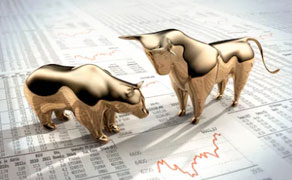The financial markets are ever-changing, influenced by economic trends, geopolitical factors, and investor sentiment. Two commonly used terms to describe market conditions are bull market and bear market. These terms represent two opposing scenarios: a bull market is marked by optimism and rising prices, while a bear market is characterized by pessimism and falling prices.
As we step into 2025, understanding these market cycles is critical for investors, traders, and anyone looking to navigate the stock, crypto, or commodity markets effectively. In this blog, we’ll explain what bull and bear markets are, how to identify them, their impact on investments, and what we can expect from the markets in 2025.
What is a Bull Market?
A bull market occurs when the prices of assets, such as stocks, cryptocurrencies, or commodities, are on a consistent upward trend over a prolonged period. A bull market is typically fueled by:
- Economic Growth: A strong economy often leads to higher consumer spending and corporate earnings, boosting stock prices.
- High Investor Confidence: Optimism among investors drives more buying activity, further pushing prices upward.
- Low Interest Rates: Borrowing becomes cheaper, encouraging businesses to expand and investors to seek higher returns in the stock market.
Key Characteristics of a Bull Market
- Rising Prices: Stock indices, such as the S&P 500 or NASDAQ, show sustained growth.
- High Trading Volumes: Increased participation by retail and institutional investors.
- Optimism in the Economy: Positive news on GDP growth, employment rates, and corporate earnings.
Example of a Bull Market
The bull market of 2020-2021, following the COVID-19 pandemic’s initial economic shock, was driven by stimulus packages, low interest rates, and optimism about technological advancements.
What is a Bear Market?
In contrast, a bear market is defined by a prolonged period of declining asset prices, typically by 20% or more from recent highs. Bear markets are often associated with:
- Economic Slowdown: Declining GDP, higher unemployment, and reduced consumer spending.
- High Interest Rates: Increased borrowing costs discourage investment and spending.
- Low Investor Confidence: Pessimism leads to selling pressure, further driving down prices.
Key Characteristics of a Bear Market
- Falling Prices: Major indices like the Dow Jones or NIFTY 50 experience sharp declines.
- Negative Sentiment: Investors become risk-averse, pulling money out of equities and into safer assets like bonds or cash.
- Low Trading Volumes: Reduced participation in the market as investors wait for recovery.
Example of a Bear Market
The bear market of 2022, spurred by rising interest rates and inflation concerns, led to significant declines in tech stocks and cryptocurrencies.
Bull vs. Bear Markets: Key Differences
| Aspect | Bull Market | Bear Market |
|---|---|---|
| Trend | Rising prices | Falling prices |
| Investor Sentiment | Optimistic | Pessimistic |
| Economic Indicators | Strong GDP, low unemployment | Weak GDP, high unemployment |
| Market Activity | High trading volumes, increased IPOs | Low trading volumes, reduced IPOs |
| Risk Appetite | High | Low |
What to Expect in 2025?
Predicting market trends requires analyzing global economic conditions, policy changes, and historical patterns. Here’s what investors can anticipate in 2025:
1. Mixed Market Conditions
Experts predict a mixed year, where some sectors experience bullish growth while others face bearish trends. For example:
- Bullish Sectors: Technology and renewable energy are expected to perform well due to continued innovation and global sustainability efforts.
- Bearish Sectors: Traditional energy sectors like oil and gas may face challenges due to regulatory pressures and reduced demand.
2. Interest Rate Dynamics
Central banks worldwide are expected to maintain moderate interest rate policies in 2025. If inflation is under control, this could support a mild bull market. However, unexpected rate hikes could lead to bearish conditions.
3. Geopolitical Influences
Geopolitical events, such as trade agreements or conflicts, will play a significant role in shaping investor sentiment. A stable geopolitical climate could fuel a bull market, while instability may trigger bearish trends.
4. Cryptocurrency Markets
The cryptocurrency market is likely to see volatility in 2025. With increasing regulatory clarity, blue-chip cryptocurrencies like Bitcoin and Ethereum may experience bullish growth, while smaller, speculative coins may struggle.
5. Artificial Intelligence and Automation
The rise of AI and automation is expected to drive growth in the technology sector, creating potential bull markets in related industries.
How to Invest in Bull and Bear Markets
Investing in a Bull Market
- Stay Invested: Ride the upward trend but diversify your portfolio to minimize risks.
- Focus on Growth Stocks: Technology, healthcare, and emerging industries tend to perform well in a bull market.
- Avoid Panic Buying: Be cautious of market bubbles and overvaluation.
Investing in a Bear Market
- Seek Safe Havens: Invest in defensive sectors like utilities and consumer staples.
- Buy the Dip: Bear markets can present opportunities to buy quality stocks at discounted prices.
- Diversify: Spread investments across asset classes, including bonds and gold.
Conclusion
Understanding bull and bear markets is crucial for making informed investment decisions. In 2025, investors should prepare for a dynamic market environment influenced by technological advancements, economic policies, and global events.
Whether you’re in a bull market or a bear market, the key to success lies in staying informed, diversifying your portfolio, and maintaining a long-term perspective. With careful planning and strategic investments, you can navigate any market condition effectively.
FAQs
Q1: What triggers a bull market?
A bull market is typically triggered by strong economic growth, low unemployment, and high investor confidence.
Q2: How long do bear markets last?
The duration of bear markets varies, but they generally last for several months to a few years.
Q3: Should I sell during a bear market?
Selling during a bear market depends on your investment goals. Long-term investors often hold their positions or buy quality stocks at lower prices.
Q4: Can a market be both bull and bear?
Yes, different sectors can exhibit bull or bear trends simultaneously based on economic and industry-specific factors.
By keeping an eye on market trends and using strategies tailored to bull and bear conditions, investors can maximize their returns and minimize risks in 2025.



































